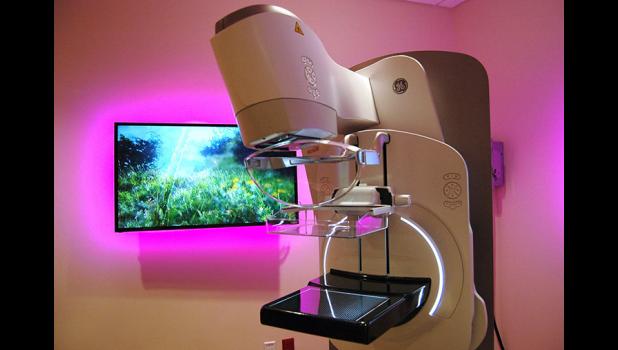GCMC offering cutting-edge mammograms
By ANDREW MCGINN
a.mcginn@beeherald.com
Soft music.
Park-like imagery on two TVs.
And, wait, is that a songbird somewhere off in the distance?
An Eastern bluebird, by chance? A black-capped chickadee?
The whole idea is to make you think of anything else besides having your breasts smushed.
The more relaxed a woman is during her mammogram, the better the image — and never before at the Greene County Medical Center has there been the capability to take a picture this thorough.
The local hospital entered the age of 3-D mammography last week with the debut of a GE Senographe Pristina, a $312,000 unit purchased by the Greene County Medical Center Foundation following months of fundraising.
“A 2-D image is like looking at a book,” explained Jennifer Miller, a technologist in the medical center’s imaging department. “And a 3-D image is like looking at each page of the book.”
But a lot still depends on being able to put the patient at ease.
“The more relaxed they get,” Miller said, “the more tissue we can image.”
Along with 3-D mammography — a process technically known as tomosynthesis mammography — the imaging department also will be offering pedicures and complimentary glasses of pinot noir.
OK. Not quite.
“This is our spa-like experience,” technologist Heather Booth said, referring to a suite that was decidedly clinical before.
Booth recalled the handles on the medical center’s 2-D mammography unit that women would clutch with something akin to a death grip — in turn causing their muscles to tense.
Unfortunately, a mammogram still requires the breast to be flattened for an X-ray picture, but 20 minutes of discomfort once a year is worth every second.
According to Miller, 80 percent of breast cancer affects women with no family history of it. Yearly screenings can detect malignant tumors that can’t be felt.
The American Cancer Society advises women ages 45 to 54 at average risk of breast cancer to get a mammogram annually. (Women ages 40 to 44 have the option to start annual screenings.)
By investing in a 3-D mammography unit, the medical center hopes women will stay close to home for their yearly screening.
The medical center was still providing as many as 800 to 900 mammograms annually with its 2-D unit, according to Miller, but prior to the introduction nationally of 3-D mammography in 2012, the medical center averaged 1,200 mammograms annually.
“We’ve had patients leave and say they’ll be back when we get 3-D,” she said. “It’s become the standard of care.”
Aside from the new “sensory suite” intended to ease the minds of women, the new unit itself has the potential to reduce anxiety.
No one wants to be called back in for a second screening, but in 2-D mammography, false-positives were common, resulting in frayed nerves.
Breasts are naturally fatty and fibrous, Booth said, and a 2-D image often made it difficult to determine whether an anomaly was cancer or just overlapping tissue.
“You’re causing a lot of anxiety,” Booth said. “Now with 3-D, we’ll have a lot less of that.”
The 3-D unit enables the radiologist to see each layer of breast.
“There’s a lot more information,” Miller said, “for the same amount of radiation.”
- Log in to post comments


